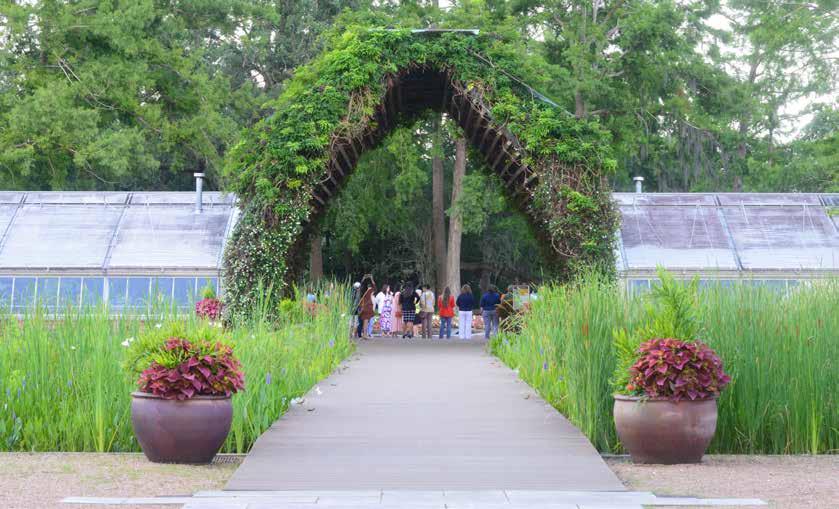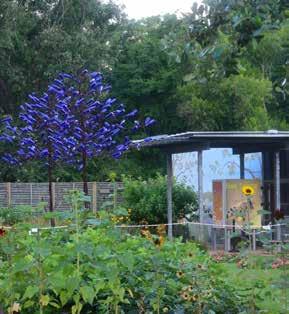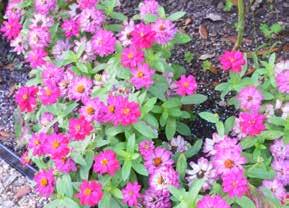
6 minute read
Shangri La reopens, ready for visitors
SHANGRI LA
reopens, ready for visitors
AAccording to the Greek myth, a maiden who fell in love with the sun god Apollo admired him so much that she would watch him each day as he rode his chariot across the sky. Eventually she turned into a flower and her face continued to turn and follow him on his fiery path. Whether or not the myth is true, Shangri La Botanical Gardens and Nature Center is home to Autumn Beauty and Velvet Queen sunflowers in its courtyard.
Reaching up to seven feet tall with flowers on multiple stems, they’ll bloom from early summer right through to frost. Not only do they make good cut flowers, they’re an excellent source of pollen, nectar, and seeds for a host of birds, bees and butterflies. These sunflowers are super easy to grow from seed and with such rich colors and so many visiting pollinators, you just may find yourself sitting in the garden watching them, according to a Facebook post from the gardens.
And it is open again to the public.
Recovering from Hurricane Lauara and then a winter freeze, beither of which took kindly to the gardens, the grounds are flourishing as Director of Horticulture Jennifer Buckner and her team work to develop and refine new planting areas that will create even more exciting WOW! moments for visitors.
Shangri La is a program of the Nelda C. and H.J. Lutcher Stark Foundation, a private operating foundation that aims to encourage and assist education and to improve and enrich the quality of life in Southeast Texas by providing significant resources for the study and enjoyment of art, history, nature and culture.
After decades of solitude following Stark’s death in 1965, the Shangri-La of the 1950s began a revitalization process through the leadership and financial support of the Nelda C. and H.J. Lutcher Stark Foundation, the private foundation established by Lutcher Stark and his wife, Nelda, in 1961. The board of directors of the Foundation recognized the unique ecosystems and rich educational opportunities of Shangri-La and, in 2002, launched a plan to restore Shangri-La to its original grandeur.
From the outset, the Stark Foundation made a commitment to honor Stark’s devotion to the environment by making the new Shangri La as earth-friendly as possible, including language in the design statement that Shangri La should be the “greenest project in Texas”. Using this philosophical framework as a foundation principle, the design teams associated with Lake/Flato Architects and the landscape architectural firms of MESA and Jeffrey Carbo Landscape Architects, began developing designs to accomplish this vision.
Unfortunately, in September 2005, as construction was poised to begin, Orange, Texas sustained a direct hit from Hurricane Rita. The resulting damage from Rita leveled

Photos by Dawn Burleigh
much of Shangri La’s upland forests and historic garden areas throughout the property, resulting in the loss of more than 50,000 trees. Despite this fact, the Stark Foundation and the design teams never wavered in their commitment to the future and took full advantage of the opportunity to salvage fallen trees and incorporate them into the design of new facilities, develop revised garden design schemes, and utilize salvaged lumber in a variety of other ways.
With its newly designed gardens, gleaming new facilities, and diverse flora and fauna, the new Shangri La, now renamed “Shangri La Botanical Gardens and Nature Center“, opened to the public in March 2008. However, nature would throw yet another significant challenge in the way when Hurricane Ike slammed into southeast Texas in September 2008, resulting in significant flood damage to the newly reopened Shangri La.
Despite these natural disasters and other challenges faced during planning and construction, the Stark Foundation’s enduring support was finally rewarded when Shangri La Botanical Gardens and Nature Center permanently reopened to the public in March 2009 following the completion of renovations. Moreover, that same spring, Shangri La was selected as one of the greenest projects in the world by the American Institute of Architects and also recognized by the United States Green Building Council as a Platinum LEED project, which is the highest level of green construction (LEED stands for Leadership in Energy and Environmental Design). Shangri La became the first Platinum LEED certified new Today, the modern Shangri La Botanical Gardens and Nature Center is nestled within 252 acres in the heart of Orange, Texas. It is an ecological wonderland and living museum for visitors of all ages to explore.
Shangri La’s Visitor Center engages visitors to become acquainted with the rich history of Shangri La, from H.J. Lutcher Stark’s original vision to the new Botanical Gardens and Nature Center. This area includes the Exhibit Hall, Discovery Theater, Exhibition Greenhouses, historic Epiphyte Greenhouse, the Here We Grow! Children’s Garden, the Wetland Demonstration Garden, Edibles Garden, a Café, and the Garden Store.
A prominent feature of Shangri La is its Botanical Gardens. Utilizing artistic concepts, the Botanical Gardens feature hundreds of plant species in artistically themed displays that are intended to inspire and amaze. The gardens include five artistic rooms and four Sculpture Gardens. A historic color garden around the reflection pool known as the Pond of the Blue Moon pays tribute to the original Shangri-La, featuring 41 varieties of azaleas, some of which belonged to H.J. Lutcher Stark in his original Shangri-La.
The modern Shangri La is also a world-class Nature Center. Visitors first experience the
Nature Center when they explore the Nature Discovery Center, a handson exhibit dedicated to Shangri La’s wetland ecosystems. Following a stroll through Shangri La’s Cypress-Tupelo swamp on a boardwalk, visitors board the Outpost Tour watercraft and enter the world of cypress swamps while travelling to one of two Outposts. At these Outposts, visitors learn about the importance of wetlands, upland forests, and grasslands to both man and wildlife.
Shangri La Botanical Gardens and Nature Center is not only a living paradise where visitors can better observe how art serves nature and nature serves art, but also a place where visitors can gain a true understanding of the complexity and fragility of our natural world.
Shangri La plays an active role in the community, too, through its environmental education programs and activities, including our annual Community Trash-Off, Scarecrow Festival and Christmas Strolls. Shangri La also hosts numerous workshops, lectures, demonstrations and programs for educators, families and organizations.
As a program of the Stark Foundation, Shangri La offers a glimpse of how people can live in harmony with nature as programs strive to Mentor Children of All Ages to Be Kind to Their World.




Join the $25 Difference
Donate $25/month and help vulnerable families buy groceries, pay bills, make rent, and maintain the stability of a roof overhead. #DoingTheMostGood #25Difference give.salvationarmytexas.org/

The Salvation Army Family store helps the community in a couple of very important ways:
When you donate goods, you're helping to provide items that are sold to the community or given to those with the greatest need. When you shop for items at our stores, you're directly funding the life-restoring programs that exist in your community.

The Salvation Army of Orange County Texas Family Store











